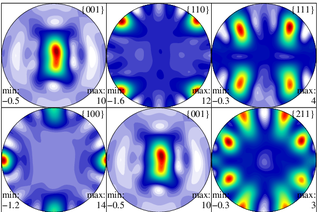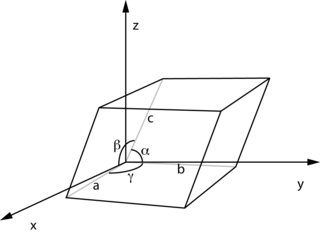Related Research Articles

Graphite, archaically referred to as plumbago, is a crystalline form of the element carbon with its atoms arranged in a hexagonal structure. It occurs naturally in this form and is the most stable form of carbon under standard conditions. Under high pressures and temperatures it converts to diamond. Graphite is used in pencils and lubricants. It is a good conductor of heat and electricity. Its high conductivity makes it useful in electronic products such as electrodes, batteries, and solar panels.

A scanning tunneling microscope (STM) is a type of microscope used for imaging surfaces at the atomic level. Its development in 1981 earned its inventors, Gerd Binnig and Heinrich Rohrer, then at IBM Zürich, the Nobel Prize in Physics in 1986. STM senses the surface by using an extremely sharp conducting tip that can distinguish features smaller than 0.1 nm with a 0.01 nm depth resolution. This means that individual atoms can routinely be imaged and manipulated. Most microscopes are built for use in ultra-high vacuum at temperatures approaching zero kelvin, but variants exist for studies in air, water and other environments, and for temperatures over 1000 °C.

Atomic force microscopy (AFM) or scanning force microscopy (SFM) is a very-high-resolution type of scanning probe microscopy (SPM), with demonstrated resolution on the order of fractions of a nanometer, more than 1000 times better than the optical diffraction limit.
Mechanosynthesis is a term for hypothetical chemical syntheses in which reaction outcomes are determined by the use of mechanical constraints to direct reactive molecules to specific molecular sites. There are presently no non-biological chemical syntheses which achieve this aim. Some atomic placement has been achieved with scanning tunnelling microscopes.

A crystallite is a small or even microscopic crystal which forms, for example, during the cooling of many materials. Crystallites are also referred to as grains.

In materials science, texture is the distribution of crystallographic orientations of a polycrystalline sample. A sample in which these orientations are fully random is said to have no distinct texture. If the crystallographic orientations are not random, but have some preferred orientation, then the sample has a weak, moderate or strong texture. The degree is dependent on the percentage of crystals having the preferred orientation. Texture is seen in almost all engineered materials, and can have a great influence on materials properties. Also, geologic rocks show texture due to their thermo-mechanic history of formation processes.

Pyrolytic carbon is a material similar to graphite, but with some covalent bonding between its graphene sheets as a result of imperfections in its production.

A lattice constant or lattice parameter is one of the physical dimensions and angles that determine the geometry of the unit cells in a crystal lattice. Lattices in three dimensions generally have six lattice constants: the lengths a, b, and c of the three cell edges meeting at a vertex, and the angles α, β, and γ between those edges.

Graphite intercalation compounds (GICs) are complex materials having a formula CXm where the ion Xn+ or Xn− is inserted (intercalated) between the oppositely charged carbon layers. Typically m is much less than 1. These materials are deeply colored solids that exhibit a range of electrical and redox properties of potential applications.
In metallurgy, materials science and structural geology, subgrain rotation recrystallization is recognized as an important mechanism for dynamic recrystallisation. It involves the rotation of initially low-angle sub-grain boundaries until the mismatch between the crystal lattices across the boundary is sufficient for them to be regarded as grain boundaries. This mechanism has been recognized in many minerals and in metals.

Feature-oriented scanning (FOS) is a method of precision measurement of surface topography with a scanning probe microscope in which surface features (objects) are used as reference points for microscope probe attachment. With FOS method, by passing from one surface feature to another located nearby, the relative distance between the features and the feature neighborhood topographies are measured. This approach allows to scan an intended area of a surface by parts and then reconstruct the whole image from the obtained fragments. Beside the mentioned, it is acceptable to use another name for the method – object-oriented scanning (OOS).
Feature-oriented positioning (FOP) is a method of precise movement of the scanning microscope probe across the surface under investigation. With this method, surface features (objects) are used as reference points for microscope probe attachment. Actually, FOP is a simplified variant of the feature-oriented scanning (FOS). With FOP, no topographical image of a surface is acquired. Instead, a probe movement by surface features is only carried out from the start surface point A to the destination point B along some route that goes through intermediate features of the surface. The method may also be referred to by another name—object-oriented positioning (OOP).
Counter-scanning (CS) is a scanning method that allows correcting raster distortions caused by drift of the probe of scanning microscope relative to the measured surface. During counter-scanning two surface scans, viz., direct scan and counter scan are obtained. The counter scan starts in the point where the direct scan ends. This point is called the coincidence point (CP). With the counter scan, the probe movement along the raster line and the probe movement from one raster line to the other raster line are carried out along the directions that are opposite to the movements in the direct scan. The obtained pair of images is called counter-scanned images (CSIs).

Nanometrology is a subfield of metrology, concerned with the science of measurement at the nanoscale level. Nanometrology has a crucial role in order to produce nanomaterials and devices with a high degree of accuracy and reliability in nanomanufacturing.
Wedge-based mechanical exfoliation is a method that involves the use of an ultra-sharp single crystal diamond wedge to penetrate inside a material and cleave a thin layer of material. It was proposed to produce few layers of graphene from a bulk highly ordered pyrolytic graphite (HOPG).
Alfred René Jean Paul Ubbelohde FRS was a Belgian-born English physical chemist.
In crystallography, mosaicity is a measure of the spread of crystal plane orientations. A mosaic crystal is an idealized model of an imperfect crystal, imagined to consist of numerous small perfect crystals (crystallites) that are to some extent randomly misoriented. Empirically, mosaicities can be determined by measuring rocking curves. Diffraction by mosaics is described by the Darwin–Hamilton equations.
Annealed Pyrolytic Graphite (APG), also known as Thermally Annealed Pyrolytic Graphite (TPG), is a form of synthetic graphite that offers excellent in-plane thermal conductivity. As with pyrolytic carbon or pyrolytic graphite (PG), APG is also low in mass, is electrically conductive, and offers diamagnetic properties that allow it to levitate in magnetic fields.

Single-layer graphene was explored theoretically by P. R. Wallace in 1947. It was first unambiguously produced and identified in 2004, by the group of Andre Geim and Konstantin Novoselov, though they credit Hanns-Peter Boehm and his co-workers for the experimental discovery of graphene in 1962. Boehm et al. introduced the term graphene in 1986.
Electrochemical AFM (EC-AFM) is a particular type of Scanning probe microscopy (SPM), which combines the classical Atomic force microscopy (AFM) together with electrochemical measurements. EC-AFM allows to perform in-situ AFM measurements in an electrochemical cell, in order to investigate the actual changes in the electrode surface morphology during electrochemical reactions. The solid-liquid interface is thus investigated. This technique was developed for the first time in 1996 by Kouzeki et al., who studied amorphous and polycrystalline thin films of Naphthalocyanine on Indium tin oxide in a solution of 0.1 M Potassium chloride (KCl). Unlike the Electrochemical scanning tunneling microscope, previously developed by Itaya and Tomita in 1988, the tip is non-conductive and it is easily steered in a liquid environment.
References
- ↑ IUPAC , Compendium of Chemical Terminology , 2nd ed. (the "Gold Book") (1997). Online corrected version: (2006–) " Highly oriented pyrolytic graphite ". doi : 10.1351/goldbook.H02823
- ↑ L. C. F. Blackman, A. R. Ubbelohde (1962). "Stress Recrystallization of Graphite". Proceedings of the Royal Society of London. A266 (1324): 20–32. Bibcode:1962RSPSA.266...20B. doi:10.1098/rspa.1962.0044. S2CID 136690560.
{{cite journal}}: CS1 maint: uses authors parameter (link) - ↑ A. W. Moore (1973). "Highly oriented pyrolytic graphite". Chemistry and Physics of Carbon. 11: 69–187.
- ↑ R. V. Lapshin (1998). "Automatic lateral calibration of tunneling microscope scanners" (PDF). Review of Scientific Instruments. 69 (9): 3268–3276. Bibcode:1998RScI...69.3268L. doi:10.1063/1.1149091. ISSN 0034-6748.
- ↑ R. V. Lapshin (2019). "Drift-insensitive distributed calibration of probe microscope scanner in nanometer range: Real mode" (PDF). Applied Surface Science. 470: 1122–1129. arXiv: 1501.06679 . Bibcode:2019ApSS..470.1122L. doi:10.1016/j.apsusc.2018.10.149. ISSN 0169-4332. S2CID 119275633.